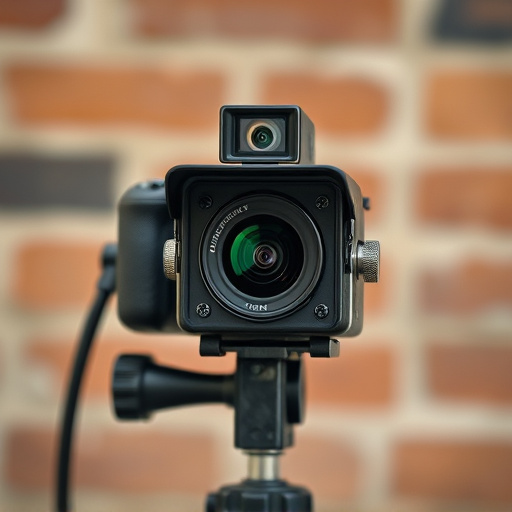Strategic placement of dummy security cameras with red lights acts as a powerful deterrent for crimes, especially in high-visibility areas like entrances and windows. This tactic enhances security without constant monitoring by signaling to potential intruders that they are under surveillance. Combining realistic dummy cameras with red light indicators creates an illusion of robust security, confusing criminals and aiding genuine security personnel. Responsible deployment respects privacy while leveraging these devices as visible deterrents, balanced between security and ethical considerations. Effectiveness can be evaluated through crime rate tracking, incident reports, and stakeholder feedback to ensure successful crime prevention.
In today’s digital era, security camera placement strategies have evolved beyond traditional methods. One innovative approach gaining traction is the strategic use of dummy cameras with red light placement (Dummy Camera Red Light Placement). This article delves into the art and science behind this tactic. We explore optimal spots for visual deterrence, advanced deception techniques, legal considerations, and ethical implications. By evaluating effectiveness through metrics and feedback, we uncover whether Dummy Camera Red Light Placement truly enhances security or merely creates an illusion of safety.
- Understanding Dummy Camera Red Light Placement
- Choosing Optimal Spots for Visual Deterrence
- Deception Techniques to Enhance Security
- Legal Considerations and Ethical Implications
- Evaluating Effectiveness: Metrics and Feedback
Understanding Dummy Camera Red Light Placement
One of the most effective ways to deter potential criminals is through strategic placement of dummy security cameras, often marked by a prominent red light. This tactic forms an integral part of any comprehensive security strategy. The red light serves as a visual signal, indicating that the area under surveillance is not to be taken lightly. Criminals are less likely to target locations where they believe they’re being watched.
Understanding how and where to place these dummy cameras is key. Positioning them in highly visible areas, such as entrances and exits, windows, and corners, can significantly reduce crime rates. The red light itself should be bright and easily noticeable, making it a powerful tool in enhancing security without the need for constant active surveillance.
Choosing Optimal Spots for Visual Deterrence
Choosing optimal spots for visual deterrence is a key aspect of deploying dummy security cameras, or red light placements, effectively. These strategic positions aim to send a clear message to potential intruders that they are being watched, thereby discouraging criminal activity. Opting for high-visibility areas like entry points, windows, and intersections within the property can significantly enhance the deterrent effect.
Consider locations where natural or artificial lighting conditions offer maximum contrast, allowing the dummy cameras to appear more realistic. Additionally, aligning the camera’s field of view with potential blind spots or areas that are difficult to observe from nearby observation points can further bolster the security measure. By combining strategic placement and realistic simulation, these dummy cameras become a powerful tool in deterring criminal behavior.
Deception Techniques to Enhance Security
Deception techniques, such as strategically placing dummy cameras or red lights, can significantly enhance security measures. These tactics create an illusion of a fully operational surveillance system, deterring potential criminals from targeting your property. By integrating realistic-looking dummy cameras with actual red light indicators, you add an extra layer of protection.
This strategy not only prevents real crimes but also acts as a powerful psychological deterrent. It conveys a strong message that any attempt at intrusion will be swiftly detected and met with consequences. Moreover, the clever use of lighting and visual deception can confuse would-be perpetrators, making it easier for genuine security personnel to identify genuine threats.
Legal Considerations and Ethical Implications
The placement of dummy security cameras, or red light placements, comes with legal and ethical considerations that cannot be overlooked. While these devices serve as deterrents and tools for crime prevention, their strategic positioning must adhere to privacy laws and rights. In many jurisdictions, there are strict rules regarding surveillance, especially in public spaces, to protect citizens from unwarranted intrusion.
Ethically, the use of dummy cameras should balance security needs with individual freedoms. They should not be employed as a means of covert monitoring or to invade personal privacy. Proper placement ensures that genuine security measures are in place while respecting the legal and ethical boundaries that safeguard civil liberties.
Evaluating Effectiveness: Metrics and Feedback
Evaluating a security camera’s effectiveness goes beyond visual confirmation. Metrics and feedback play a crucial role in understanding its impact on deterring crime and enhancing safety. By analyzing data like crime rates, incident reports, and stakeholder feedback, you can assess whether the dummy camera red light placement strategy is achieving its intended results. For instance, tracking a reduction in reported crimes within the surveillance zone provides tangible evidence of improved security. Additionally, gathering feedback from business owners, residents, or law enforcement agencies can offer qualitative insights into the perception of safety and any observed changes in behavior since the installation of dummy cameras. This combined quantitative and qualitative approach ensures a comprehensive evaluation, guiding future adjustments to the security strategy.
Fake security camera placement, employing dummy camera red light strategies, offers a powerful visual deterrent for potential intruders. By strategically positioning these devices in high-risk areas, property owners can create the illusion of enhanced surveillance, effectively deterring criminal activity. This article has explored key aspects from understanding red light placement to legal considerations, emphasizing that while dummy cameras provide a cost-effective security measure, their effectiveness relies on clever and informed installation. Continuous evaluation and feedback are essential to ensure these tactics remain impactful, balancing physical security with ethical implications in today’s digital age.
